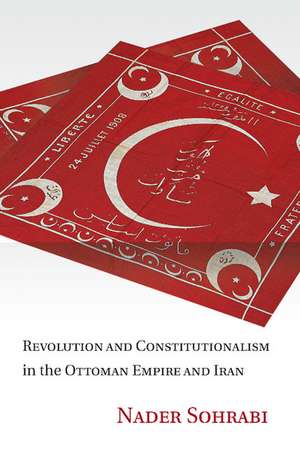Revolution and Constitutionalism in the Ottoman Empire and Iran
Autor Nader Sohrabien Limba Engleză Paperback – 25 iun 2014
| Toate formatele și edițiile | Preț | Express |
|---|---|---|
| Paperback (1) | 361.00 lei 6-8 săpt. | |
| Cambridge University Press – 25 iun 2014 | 361.00 lei 6-8 săpt. | |
| Hardback (1) | 959.23 lei 6-8 săpt. | |
| Cambridge University Press – 30 oct 2011 | 959.23 lei 6-8 săpt. |
Preț: 361.00 lei
Nou
Puncte Express: 542
Preț estimativ în valută:
69.09€ • 71.86$ • 57.03£
69.09€ • 71.86$ • 57.03£
Carte tipărită la comandă
Livrare economică 12-26 aprilie
Preluare comenzi: 021 569.72.76
Specificații
ISBN-13: 9781107458901
ISBN-10: 1107458900
Pagini: 458
Dimensiuni: 155 x 235 x 27 mm
Greutate: 0.7 kg
Editura: Cambridge University Press
Colecția Cambridge University Press
Locul publicării:New York, United States
ISBN-10: 1107458900
Pagini: 458
Dimensiuni: 155 x 235 x 27 mm
Greutate: 0.7 kg
Editura: Cambridge University Press
Colecția Cambridge University Press
Locul publicării:New York, United States
Cuprins
1. Introduction; 2. The state of revolution; 3. The Young Turk Revolution and the global wave; 4. Constitutional struggles and struggle for the constitution; 5. Government within the government: the purges; 6. Counterrevolution; 7. Iran: reform and patrimonialism in comparative perspective; 8. The unlikely revolution: the constitutional revolution of 1906 in Iran in light of the Young Turks; 9. Concluding remarks.
Recenzii
'Revolution and Constitutionalism is a masterful account of class-based grievances, revolutionary developments, shifts in political stances, counter-revolutionary backlashes, regime changes and their institutional legacies. Artfully reconstructing multiple temporalities as they get intertwined in highly contentious times, this book offers the rare combination of comprehensiveness and precision thoroughly documented by an impressive range of primary and contemporary sources. A remarkable achievement. Ivan Ermakoff, University of Wisconsin-Madison
'At the beginning of the 20th century, three revolutions broke out almost at the same time in Eastern Europe and the Middle East: the Russian (1905), Iranian (1906), and Ottoman (1908) revolutions. All three had the same objective: to establish a constitution in order to end arbitrary and despotic regimes. Taking head-on the last two revolutions, the Iranian and Ottoman, Dr. Nader Sohrabi has written a landmark book in contemporary historiography. Based on an intimate knowledge of Ottoman and Persian sources, this is a carefully written book which opens new perspectives on the history of Iran and the Ottoman Empire. The way the author uses different scales and levels of analysis - local, regional and global - throws a bright light on the origins and the course of these revolutionary movements. In a very illuminating way, he shows the role of the actors on the spot and the underlying political, economic, social, cultural forces at stake. He draws enlightening comparisons between the situation in Iran and in the Ottoman Empire. Sohrabi's wonderful book brings the reader to think deeply about revolutions in non-European contexts, and it provides essential keys for understanding events unfolding before our eyes, unlike so many essays written after the fact. This is a seminal work: it will be essential for any reader who wants to understand the past as well as the present.' François Georgeon, Centre National de la Recherche Scientifique
'This highly analytical study aims at situating the Young Turk Revolution of 1908, one of the momentous political developments of the early twentieth century and a topic of importance not only for Turkey but for all the territories in Europe, Asia, and Africa that formed part of the Ottoman Empire at that time, in the larger sociological context of revolutions. The study is also revolutionary in that it ascertains the importance of two major early twentieth-century revolutions (the 1905–06 Iranian and 1908 Young Turk revolutions) generally overlooked by major theoreticians. With meticulous archival research, Dr. Sohrabi ably and in great detail reinterprets important episodes of late Ottoman history and society.' M. Sükrü Hanioglu, Princeton University
'The depth of research and the breadth of vision that have shaped this book are truly breath-taking. Sohrabi places the Young Turk and the Iranian revolutions in their temporal and regional context and evaluates them from a comparative perspective. Sohrabi's command of the Middle Eastern and Western European sources and his theoretical sophistication combine to make this a powerful and persuasive book. It is unlikely that anything that even comes close to Revolution and Constitutionalism in the Ottoman Empire and Iran will be published for a very long time. Resat Kasaba, University of Washington
'Nader Sohrabi's Revolution and Constitutionalism in the Ottoman Empire and Iran is a major contribution to the literature on the history to the late Middle East … Sohrabi's book offers an excellent framework not only for analyzing the covered region but for comparative studies as a whole. It throws new light on the effects of constitutionalism and the rise of the middle class in the Middle East. It sets the bar high for future research, with its command of archives combined with scrutiny for the multi-disciplinary scholarship, I urge every scholar interested in the region or the era to read this exemplary study.' Berke Torunoğlu, International Journal of Turkish Studies
'By forcing the readers to reevaluate their assumptions about revolutions and constitutionalism, it scrutinizes two of the most important revolutions in a region that is once again going through radical political transformation. Sohrabi, pointing toward the importance of the interaction between the global zeitgeist and local dynamics, makes a very strong case for historicizing revolutions 'by considering the times - and the ideologies associated with those times - as a chief organizing principle' (p. 2). Revolution and Constitutionalism is a most timely book that can help us understand not only the historical roots of revolution in the Middle East, but also its present-day incarnations.' Burak Kadercan, Comparative Political Studies
'To put it bluntly and succinctly, Nader Sahrabi's book is an impressive tour-de-force of sociological analysis and historical contextualization … This review very much doubts that anything better will ever be produced on this subject.' M. Sükrü Hanioglu, Middle East Journal
'Sohrabi's rigorous and in-depth comparison of these revolutions offers fascinating insights into the processes of political and social change, while his highly readable historical accounts of revolt and counterrevolution restores agency to the Middle Easterners who pushed the limits of constitutional monarchy in the decade that preceded the Bolshevik Revolution. Given the events in the region, one hopes that the publisher will soon reissue this volume in a paperback edition so this pathbreaking study will reach the wide, multidisciplinary audience it deserves.' Ariel Salzmann, American Journal of Sociology
'In the end, Sohrabi's work should be regarded as a major contribution to the historiography of revolutions, constitutionalism, late Ottoman history, and Iranian history. The book is a must for every graduate student, scholar, historian and social scientist interested in exploring the different dimensions of revolutions and the consolidation of constitutional regimes. Sohrabi's book has charted new ground and displays a level of scholarship equal to the sophisticated studies that have been undertaken by the likes of William H. Sewell Jr, Marshall Sahlins, and James C. Scott in their respective fields.' Bedross Der Matossian, Review of Politics
'What Sohrabi has undertaken is very original in three aspects. First, he historicizes revolutions by considering contemporaneous ideologies as the chief organizing principle. Second, he approaches the 1908 Young Turk and 1906 Iranian revolutions not chronologically, but as comparative cases in relation to how each one negotiated ideologies. And third, he simultaneously engages the insights provided by the social sciences, history, and area studies on the one side and global, regional, and local level analyses on the other.' Fatma Müge Göçek, American Historical Review
'This book provides a brilliant interpretation of the first two decades of the Young Turk Revolution (1902–18) and of the constitutional period of the Qajar Dynasty in Iran. Further, Sohrabi embeds this comparative constitutional study in the wider global history of constitutional movements, especially the 1905 Russian Revolution that greatly impacted the Young Turk and Iranian movements … Summing up: highly recommended.' R. W. Olson, CHOICE
'On the whole this book is a major contribution to the historiography and sociological analysis of constitutional revolutions in the Ottoman Empire and Iran and will be essential reading for future scholarship.' Ali Gheissari, Iranian Studies
'At the beginning of the 20th century, three revolutions broke out almost at the same time in Eastern Europe and the Middle East: the Russian (1905), Iranian (1906), and Ottoman (1908) revolutions. All three had the same objective: to establish a constitution in order to end arbitrary and despotic regimes. Taking head-on the last two revolutions, the Iranian and Ottoman, Dr. Nader Sohrabi has written a landmark book in contemporary historiography. Based on an intimate knowledge of Ottoman and Persian sources, this is a carefully written book which opens new perspectives on the history of Iran and the Ottoman Empire. The way the author uses different scales and levels of analysis - local, regional and global - throws a bright light on the origins and the course of these revolutionary movements. In a very illuminating way, he shows the role of the actors on the spot and the underlying political, economic, social, cultural forces at stake. He draws enlightening comparisons between the situation in Iran and in the Ottoman Empire. Sohrabi's wonderful book brings the reader to think deeply about revolutions in non-European contexts, and it provides essential keys for understanding events unfolding before our eyes, unlike so many essays written after the fact. This is a seminal work: it will be essential for any reader who wants to understand the past as well as the present.' François Georgeon, Centre National de la Recherche Scientifique
'This highly analytical study aims at situating the Young Turk Revolution of 1908, one of the momentous political developments of the early twentieth century and a topic of importance not only for Turkey but for all the territories in Europe, Asia, and Africa that formed part of the Ottoman Empire at that time, in the larger sociological context of revolutions. The study is also revolutionary in that it ascertains the importance of two major early twentieth-century revolutions (the 1905–06 Iranian and 1908 Young Turk revolutions) generally overlooked by major theoreticians. With meticulous archival research, Dr. Sohrabi ably and in great detail reinterprets important episodes of late Ottoman history and society.' M. Sükrü Hanioglu, Princeton University
'The depth of research and the breadth of vision that have shaped this book are truly breath-taking. Sohrabi places the Young Turk and the Iranian revolutions in their temporal and regional context and evaluates them from a comparative perspective. Sohrabi's command of the Middle Eastern and Western European sources and his theoretical sophistication combine to make this a powerful and persuasive book. It is unlikely that anything that even comes close to Revolution and Constitutionalism in the Ottoman Empire and Iran will be published for a very long time. Resat Kasaba, University of Washington
'Nader Sohrabi's Revolution and Constitutionalism in the Ottoman Empire and Iran is a major contribution to the literature on the history to the late Middle East … Sohrabi's book offers an excellent framework not only for analyzing the covered region but for comparative studies as a whole. It throws new light on the effects of constitutionalism and the rise of the middle class in the Middle East. It sets the bar high for future research, with its command of archives combined with scrutiny for the multi-disciplinary scholarship, I urge every scholar interested in the region or the era to read this exemplary study.' Berke Torunoğlu, International Journal of Turkish Studies
'By forcing the readers to reevaluate their assumptions about revolutions and constitutionalism, it scrutinizes two of the most important revolutions in a region that is once again going through radical political transformation. Sohrabi, pointing toward the importance of the interaction between the global zeitgeist and local dynamics, makes a very strong case for historicizing revolutions 'by considering the times - and the ideologies associated with those times - as a chief organizing principle' (p. 2). Revolution and Constitutionalism is a most timely book that can help us understand not only the historical roots of revolution in the Middle East, but also its present-day incarnations.' Burak Kadercan, Comparative Political Studies
'To put it bluntly and succinctly, Nader Sahrabi's book is an impressive tour-de-force of sociological analysis and historical contextualization … This review very much doubts that anything better will ever be produced on this subject.' M. Sükrü Hanioglu, Middle East Journal
'Sohrabi's rigorous and in-depth comparison of these revolutions offers fascinating insights into the processes of political and social change, while his highly readable historical accounts of revolt and counterrevolution restores agency to the Middle Easterners who pushed the limits of constitutional monarchy in the decade that preceded the Bolshevik Revolution. Given the events in the region, one hopes that the publisher will soon reissue this volume in a paperback edition so this pathbreaking study will reach the wide, multidisciplinary audience it deserves.' Ariel Salzmann, American Journal of Sociology
'In the end, Sohrabi's work should be regarded as a major contribution to the historiography of revolutions, constitutionalism, late Ottoman history, and Iranian history. The book is a must for every graduate student, scholar, historian and social scientist interested in exploring the different dimensions of revolutions and the consolidation of constitutional regimes. Sohrabi's book has charted new ground and displays a level of scholarship equal to the sophisticated studies that have been undertaken by the likes of William H. Sewell Jr, Marshall Sahlins, and James C. Scott in their respective fields.' Bedross Der Matossian, Review of Politics
'What Sohrabi has undertaken is very original in three aspects. First, he historicizes revolutions by considering contemporaneous ideologies as the chief organizing principle. Second, he approaches the 1908 Young Turk and 1906 Iranian revolutions not chronologically, but as comparative cases in relation to how each one negotiated ideologies. And third, he simultaneously engages the insights provided by the social sciences, history, and area studies on the one side and global, regional, and local level analyses on the other.' Fatma Müge Göçek, American Historical Review
'This book provides a brilliant interpretation of the first two decades of the Young Turk Revolution (1902–18) and of the constitutional period of the Qajar Dynasty in Iran. Further, Sohrabi embeds this comparative constitutional study in the wider global history of constitutional movements, especially the 1905 Russian Revolution that greatly impacted the Young Turk and Iranian movements … Summing up: highly recommended.' R. W. Olson, CHOICE
'On the whole this book is a major contribution to the historiography and sociological analysis of constitutional revolutions in the Ottoman Empire and Iran and will be essential reading for future scholarship.' Ali Gheissari, Iranian Studies
Notă biografică
Descriere
This is an analysis of the constitutional revolutions in the Ottoman Empire and Iran in the early twentieth century.














